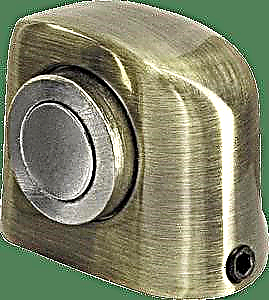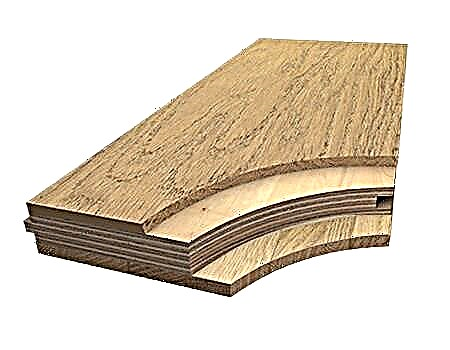When all the large-scale work on the site is over - the house is built, the fence is built, the trees are planted, the paths are laid, and the sites are paved, it is time to think over the design of the flowerbeds in the country house to give your own suburban possession a complete look. An inhabited, cozy hacienda is inconceivable without beautiful flower beds creating a mood and a joyful feeling of country life.
Varieties of country flower beds
A flower bed is the general name of all flower or decorative plantings fenced or having a clear shape.
- Varieties of flower beds: free (landscape), regular (strict forms, symmetrically executed), from summers, perennials, including decorative trees, shrubs, various species of conifers.
- Mixborder is an elongated flowerbed along the paths enclosing structures, where plants are selected in height from shorter to higher, and in terms of flowering so as to look spectacularly most of the vegetative period.
- Parterre is an extensive flower garden of strict form (square, rectangle), which occupies a central place in the garden, where plants are planted with contrasting patterns.
- Rabatka is a strip bordering the paths, where relatively low flowering plants create a distinct ornament.
- Making a front garden - involves planning flower beds from the gate to the entrance of the house, with the presence of tapeworms (single plants that attract attention) to create a beautiful appearance of the cottage, viewed from the driveways.
When choosing plants for flower beds, consider the timing of flowering, so that some flowers replace the others, and the flower bed is not empty. Keep in mind that each plant species has its own “early birds” and “owls”, i.e. varieties that bloom later with a difference of 2-3 weeks.
An important point in the breakdown of the flower bed, which must be taken into account, is the possibility of viewing it. Some flower gardens suggest a circular appearance, i.e. they are equally spectacular from several viewpoints. Flower beds of a flat look look better from elevations, are interesting for use on sites with slopes and terraces. Vertically and horizontally oriented flower beds emphasize the necessary dominants, visually expand the space or add a suburban corner of chamberness.
Where to begin
Thinking to create a decorative corner - a flower bed on your personal plot, you need to perform several sequential operations:
- Collect illustrative material (magazines with schemes of flower beds, sites on landscape design, gardening forums on the Internet will help with this).
- Decide on the desires and opportunities (which plants you like, what will survive in a particular climate, what are the material resources allocated for the purchase of planting material).
To reduce financial costs will help to grow the required number of copies from seeds. This process takes more time, but does not hit the family wallet, especially if the area of the flower beds is large, and the number of plants is selected to a hundred or more.
- To break a flower bed, to think over its protection (a stone, a tree, concrete, plastic, an earthen groove separating a flower bed from a lawn).
- Prepare the land for planting (add the necessary soil components, make the required fertilizers).
- Create a scheme (your own sketch), taking into account the size (height and width) of plants.
- Decide how the flowerbed will be planted - for growth or so that it looks good on the first day. Calculate planting density.
- Place pots with plants on the square to check the correctness and harmony of their placement not on paper, but visually.
- Landing by watering. Mulch open areas of land between plants, leaving clean ground 10-15 cm from the stems (trunks).
- Maintain plant survival (provide necessary watering, shading, if the weather is very hot).
- Enjoy the result and start making new plans.
Which plants to choose
So that the flower garden captivates guests and delights the family for a long time (for example, peonies and clematis grow in one place for several decades), select only climate-resistant, unpretentious plants. Having landed extremely liked, but demanding care and shelter, poorly tolerating Russian winters copies, you will carefully look after them.
However, after 3-5 years, removing dead bushes that did not survive the winter in the spring, you will realize that there is no more strength to take care of whims. At this point, you will decide to replace all "southerners" with regionalized ornamental plants. So why not immediately pay attention to those flowers that feel good in your climate?
The initial selection for the beds of suitable planting material, varieties and species resistant to the climatic conditions of the region has many advantages:
- Easy maintenance (no need to build serious winter shelters).
- Preservation of one’s own nervous system (lack of worries about poorly covered or untimely open plants, fear of mopping up, getting wet, damage by moles or mice who like to house in winter under shelters).
- Lower financial costs (there are no costs for the purchase of new plants for replacement).
- Reduced labor costs (there is no annual digging of "dead" specimens and landing new ones in their place).
- A more accurate appearance of flower beds in the winter (even snowy spaces with shrubs covered with hoarfrost or snow caps look much more presentable than wooden boxes or arc structures throughout the site).
Every enthusiastic summer clerk, feeling like a landscape designer of a particular site, needs a rest. Without time to admire one's own achievements, there will be no pleasure in the accomplished task and the country life as a whole. Therefore, plant more unpretentious plants, they will allow you to enjoy the surrounding beauty more.
Fashion trends and custom solutions
Modern landscape design offers a wide variety of compositions of flower beds in a suburban area. The main direction is “harmony in simplicity”. There are several ways to implement it.
| Type of design | Decision |
| Monochrome (using a single color scheme) | Greens of different shades: silver-green, blue-green, dark green, lemon green |
| Green and white: tree hydrangea, derain, astilbe, white peonies, primrose with white flowers, stalk, hosta with spotted leaves, spirea wangutta, mock | |
| Green-pink: peonies, roses, clematis, astilbe, geyhera, chrysanthemum, incense | |
| Red: red-leaved maples, decorative barberries, heichera | |
| Monoformity (selection of planted plants of a single form) | Connection in one flowerbed of plants with a round crown: spherical willow, spherical thuja, round spirea, large hydrangea bushes, roses on the stem, rounded forms of herbaceous plants (gray fescue) |
| Contrast (choice of plants with flowers of saturated colors) | Blue-yellow (delphinium, irises, viols, suitable varieties of marigolds, nasturtiums, yellow daylilies) |
| Blue-pink (roses and a frame of lavender, verbena, matthiola bicorn) |
Another interesting technique is the creation of vertical flower beds. Strengthening flower containers on the walls of buildings and planting bright summers in them will decorate the boring corners of the garden, and the creation of columns with petunias placed along the entire height will add originality and rich aroma, turning a flat area into a luxurious voluminous flower garden. Planted near an old tree, clematis (it is possible to use a species as more resistant to adverse conditions) will cover the trunk with a flower wave, delighting the summer resident with continuous flowering for 3 months.
Decorative design of flower beds in a summer cottage
The rules of landscape design allow you to decorate flower beds with a variety of decorations. Practically any of them, with some effort, can be made with your own hands. Such a move is especially appropriate when arranging central flower beds, where the decorative element is viewed from all sides, as well as the "secret corners" for relaxation, hidden from a direct look and full of intimate charm.
As the basis around which the composition of the flowerbed is formed, it is often used:
- mosaic balls, bird drinkers, sundials,
- wooden driftwood, carts, logs, stumps, wheels,
- sculptures
- mirrors
- trellis, arches, figured constructions,
- plants with a dense crown, trimmed in the form of various figures (art of topiary).
Each of these elements solo in the flowerbed. Plants of different sizes create a common background, and some specimens (for example, climbing roses) often perform with a duet.
In addition to the central elements, a large role in the decorative design of flower beds is played by:
- fencing
- solar powered lights
- mulching with colored chips, different shades of gravel.
In the latter case, the alternation of multi-colored wavy stripes is able to emphasize the interesting shape of the flowerbed or to advantageously give a bright plant.
The combination of beautiful and healthy
Recently, in landscape design, it has become fashionable to use decorative beds in a regular style instead of flower beds. Placing an artistically broken garden near the house allows you to enjoy a beautiful view, concentrated smells of herbs and save time (everything you need for a salad is nearby).
In the original (the French royal garden), the framing of the beds was made of sheared boxwood. In our climate, this plant requires shelter for the winter, but even it does not guarantee survival. And his "deputy" - privet will require a lot of time for a haircut to maintain the curb in perfect shape.
Therefore, when dividing flower beds by the type of “decorative garden”, it is better to limit yourself to creating raised beds from timber, thick treated boards with platbands along the upper perimeter, or lay out walls made of slab stone.
Having laid an earthen composition inside the beds, it remains only to plant garden plants in even rows or geometric patterns. A contrasting pattern can be obtained by arranging different varieties of lettuce (green, red, lemon flowers), purple and green basil, varieties of decorative cabbage (it can be eaten), dividing the space into cells, using as a border a line of radish or dill.
Popular flower garden design ideas
In order to arrange a beautiful flower garden, you need to carefully consider the time of flowering plants, as well as where exactly you plan to arrange your favorites in the country, for example, you can use the photo of ready flower beds. Fertilizers are applied to the selected place in advance.

As a rule, a personal plot contains several flower arrangements. It is important to adhere to optimal proportions of 3: 5: 8. In this case, there will be no feeling of piling up.

It is customary to distinguish several varieties of flower islands:
- border design
- mixborder
- consisting of beautiful flowers of the same type, monoclomb,
- various flowerpots, the use of non-standard items,
- multi-level breakdown of the flower garden, assuming plants of different sizes, as well as step planting,
- vertical lawns located on a plane
- group plantings of perennials, supplemented by annuals.

Rabatka
A rectangular flower garden that can be located near a building or walkway. Often such a flower bed is divided into several paths. At the same time, you can sow them with flowers of different flowering times, in which case your garden will be fragrant throughout the summer.

A distinctive feature of the rabatka is its geometric rigor. It can be stripes or rhombuses, circles or squares, the main thing is to observe two rules:
- You should not collect on one bed many varieties of plants. Three to five kinds of flowers look much more harmonious.
- Be sure to keep in mind that this is a long flowerbed, so some areas may fall into the shade, while others are always under the scorching sun. Therefore, it is very important to consider which plants you want to plant and where.

Mixborder
The most popular flower beds allow you to combine flowering shrubs and perennial flowers, create a very complex composition that does not stop flowering all summer. If you make coniferous and deciduous dwarf plants in these composite islands, it will delight you all year.
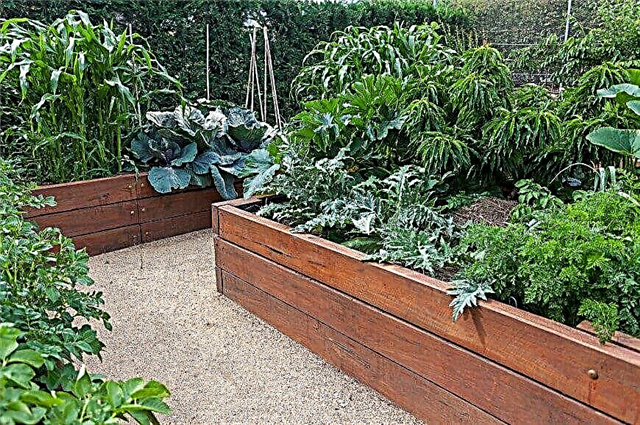
However, it should be remembered that such a flower garden is created for several years, annual flowers only complement and refresh the composition, filling up free space.

Stone garden
A very interesting decorative solution for decorating the garden is the rock garden. In fact, this is a flat platform on which large stones are located in a chaotic order. This is an apparent accident. There are several immutable rules:
- Groups of stones are arranged in three pieces side by side, it is this quantitative combination that brings peace.
- Around the triads are circular grooves symbolizing the waves. They can be made using small pebbles or a thin layer of small flowers.
- The basis of the rock garden is usually sand or small pebbles, since the classic rock garden symbolizes the ocean, and the stones are islands in it. However, it may well be a grass lawn or anything else, it all depends on your imagination.
- The main principle is to observe the same number of stones from any point of view.

Border
Very popular for decorating cottages are live borders. The material from which they will be made is up to you. Whether it will be only plants, or you combine them with a stone, and possibly a tree, your imagination will tell.
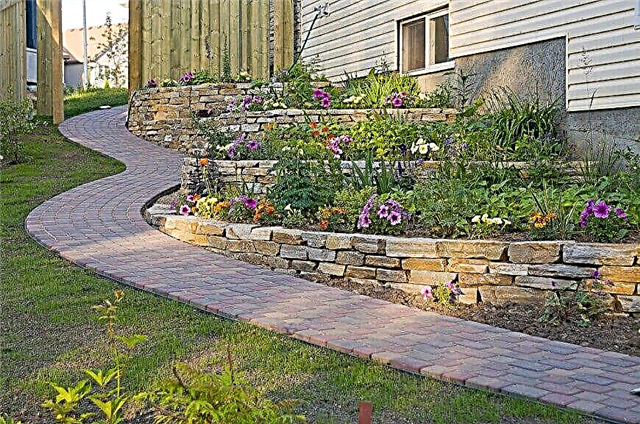
The main requirement of the border are the parameters:
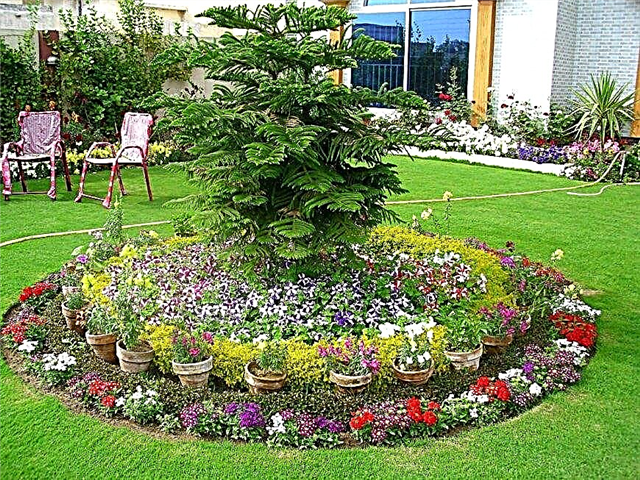
It is believed that undersized shrubs will be the ideal plant for the border.

Flower bed on stumps
Many gardeners have adapted to use sawn stumps and logs for their flower beds. Such an original flowerbed can act as an independent element of landscape design or fit into the overall composition of a large flower garden:
- As you can easily guess, use as a basis for flower beds, you can only healthy stumps and logs. Remains of trees affected by any diseases will not only not give the expected result, but will also pose a potential threat to other plants.
- To disinfect an impromptu flowerbed, treat it with a disinfectant. Oil paint is perfect.
- To create a flower bed, dried plants are best suited, from which the core is easily removed.
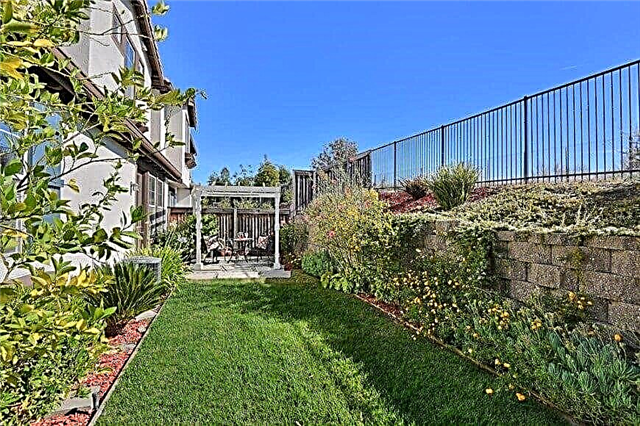
Fence ideas for flower beds
Using flower garden schemes, you can create many flower islands in the country. Separately, it should be said about fences. This is not only a decorative detail.

Such a "fence" will prevent your flower garden from sprawling, perfectly divide the infield into zones and protect against accidental games of children and animals in the flower bed. It is customary to subdivide the following varieties of material for creating fencing:
- tree,
- a rock,
- metal,
- plastic,
- fencing from improvised materials.
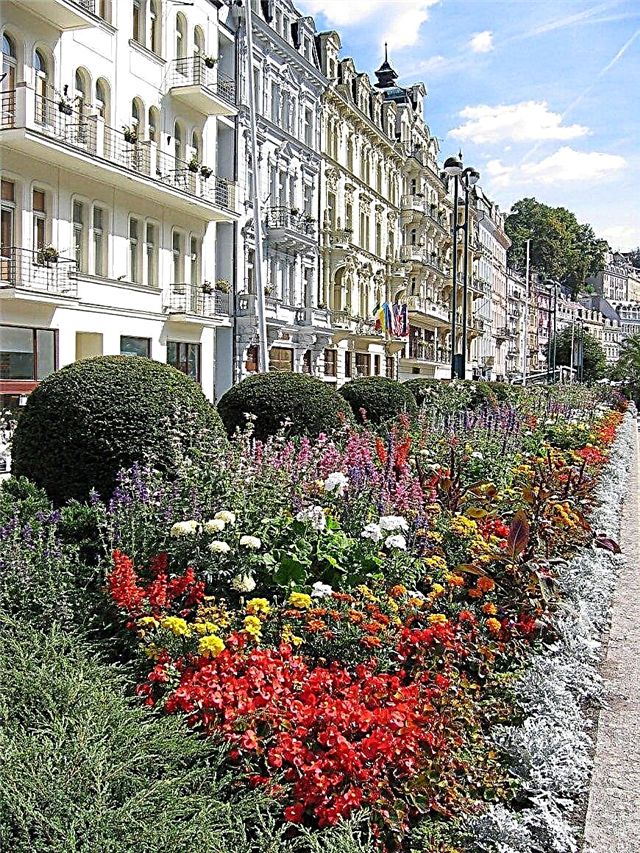
The height of the fence is determined depending on which plants will grow on the flowerbed. Necessarily takes into account the functional load of the fence:

If you decide to use a fence for simple separation, for example, to indicate the area of the lawn and flower garden, a small fence about 5-7 centimeters high is perfect.

In case the fence is also a curb for the garden path, you will need a more stable and powerful fence, the height of which should be at least 10 centimeters.
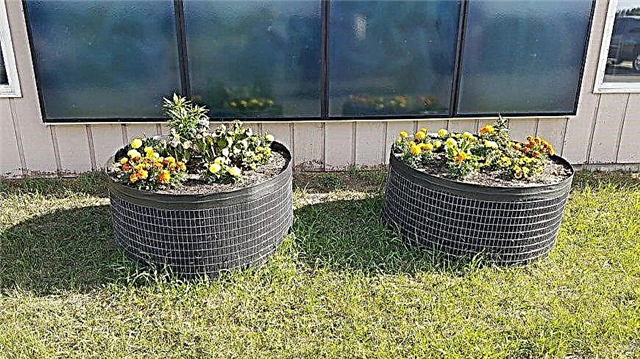
Brick or stone fences are most often used for flower beds raised above the ground, since in this case it is necessary to hold the soil. It is also important to maintain a stable shape of the flowerbed. Therefore, the fence must be stable and durable.

To prevent the flower garden from growing and to block long roots, a fence is required, recessed into the ground to a sufficiently large depth. For these purposes, usually use a plastic tape or stone. A tree in such conditions is a poor helper, because it will quickly collapse

When fencing flower beds from children and pets, it is necessary to put a fence of at least 40 centimeters. Most often, “transparent” options are used: picket fences made of wood, metal or plastic. This allows you not to visually clutter up the space with a high fence.
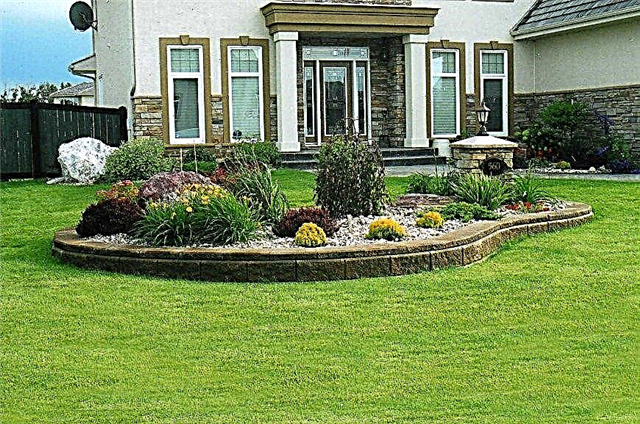
Flower Care Tips
Having carefully planned and planted a flower arrangement, you should take care of it throughout the entire time. The main care activities are:

Any plant needs weeding. No exception and floral arrangements. Timely disposal of weeds will prevent clogging of the soil. Cultivated plants need enough moisture, sunlight, and nutrients. Otherwise, they quickly fade.

Without fail, the flower garden needs watering. This is especially true for the first few weeks after planting. Rooted plants should be watered only in stable, dry weather, tracking the potential risk of soil drying out.

Depending on the season, annual and perennial plants require appropriate events.
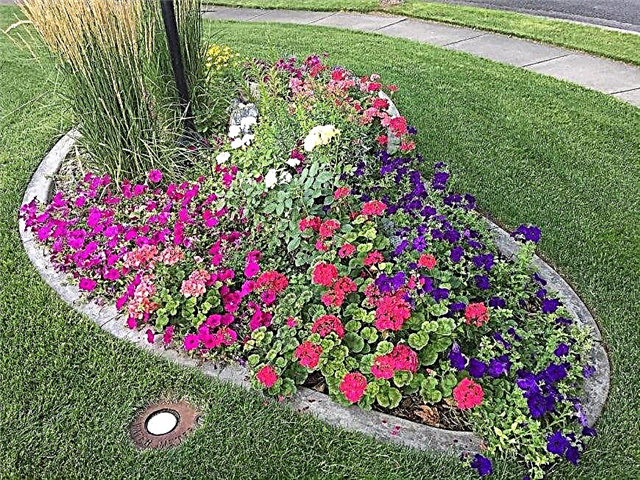
Fertilize according to the planting schedule, and also make sure that the soil does not contain excess root. This can lead to the abundant formation of the vegetative component of the plant. The floral part will be very scarce.

Do not forget about protecting the flower garden from harmful insects and all kinds of diseases.

Summing up, it should be recalled that the creation of a bright flower bed is a creative process. That is why there are no two identical flower beds. For the successful completion of the work, you will need to make an effort, but the result will more than reward you for your efforts.
DIY new flower beds


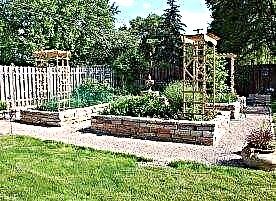





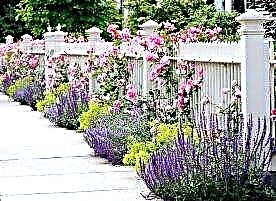











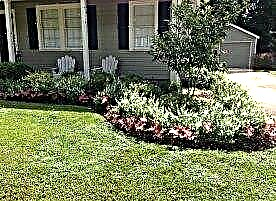




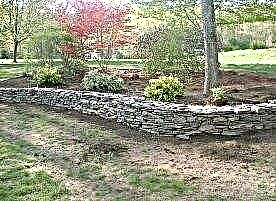



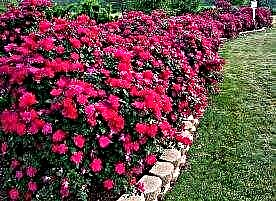



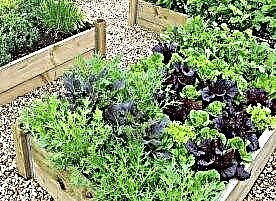

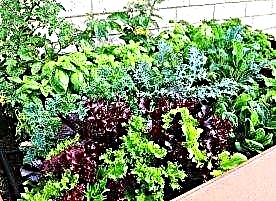

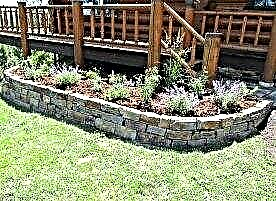

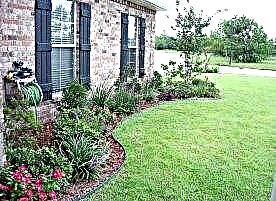



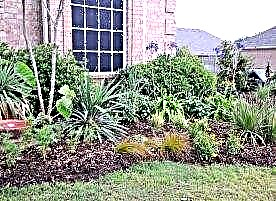

Question answer
Seedlings for such flower beds are grown independently. If you grow all the plants from seeds or cuttings, then you will have to work hard before arranging the flower beds. But the result will also be unique, the varieties will be exclusive, and in the assortment of types and colors you will not be limited by anything.
Favorite carpet species of annual plants or the most undersized summers allow you to create a dense texture of flower-carpets and various contrasting patterned transitions. However, stones for the garden, it will be necessary to choose large so that they do not get lost against the background of plants.
When planting flowers, it is important to consider the recommended distance to neighbors for each individual species. If placed too rarely, such a flower garden will look sloppy and careless; if it is too dense, the plants will develop poorly, get sick, and may not bloom at all.
Varieties of flower beds
Considering the diversity of species of flower beds, we can distinguish several options for their solution.
- Rabatka. Located along the garden paths. Repeating all the bends, turns, low plants create a clear line. The hue solution can be varied. When choosing it, take into account the features of the surrounding landscape.
- Mixborder. It is an elongated flowerbed near buildings, fences, borders between individual zones within the site. A feature is the planting of plants, taking into account their height. The flowers with the longest stems are in the background.
- Parterre. Such a square or rectangular large flower bed is located in the center of the site. The flower cultures planted on it create interesting patterns, ornaments, usually with a contrasting sound.
- Arabesque. This name is oval or round miniature flowerbed.
- Border. It is created from ground cover low-growing plants.
- Rockery (rock garden). They are harmonious combinations of vegetation and stones of various sizes and configurations.

Unusual use of wooden barrels as a flower garden
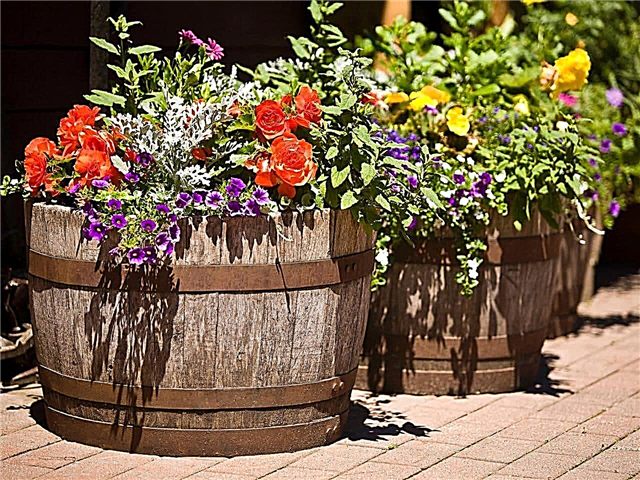
Using a creative approach, any thing can become a unique piece of garden decor

An original approach to the arrangement of a reservoir in the country
Depending on the shape, several varieties of flower beds are distinguished:
- Geometric. They have a clear contour, the correct configuration.
- Natural. Represent a free outline imitating a free arrangement of plants.
- Raised. They are created inside high fences, giving a decorative unusual design.
- Monochrome. On such flower beds one variety of plants is grown.
- Tiered. Special constructions having several levels are pre-mounted. They plant flowers and green ornamental plants. Compact varieties are usually selected.
- Symmetrical. Bring orderliness to the landscape.
- Combined. Variations of combination in color, shape, height, there is an immense multitude.

Bright and cozy corner for unforgettable dates and romantic evenings
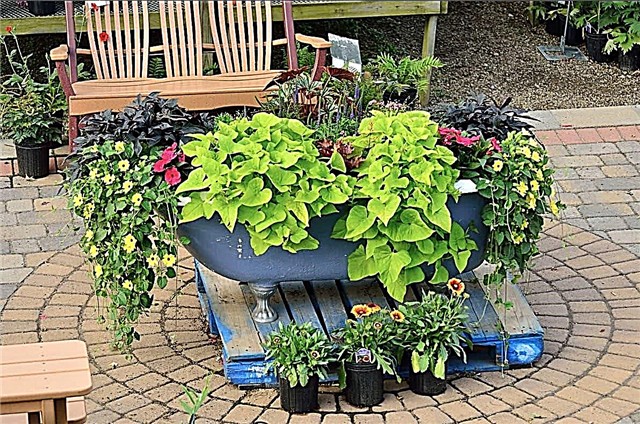
An old cast-iron bathtub with flowers planted in it can safely claim to be the best flower bed in the garden
Stages of creating a flowerbed in the garden (step by step)
It is recommended to take the time to create a project for future flower objects. This will make it possible in the future not to be disappointed due to possible disharmony.
- Analyze a variety of illustrative material using print and electronic publications on landscape design.
- The preferred color scheme is determined. The further acquisition of flower crop seeds depends on this.
- Choose the location of flower beds depending on the characteristics of the plants. If they are photophilous, they have flower beds in a distance from trees, tall buildings.
- Provide a care approach. Shade-tolerant crops will be comfortable near walls and fences. They make out the entrance to the site. Often planted next to the gazebo or in tree trunks.
- Think over the configuration, the presence or absence of a decorative fence. Create a plot scheme on a scale and apply all planned flower beds to it. They make the plan necessarily in color, which will allow, if necessary, to correct unsuccessful combinations.

Every flowerbed in this beautiful and fabulous garden evokes genuine delight and tenderness.
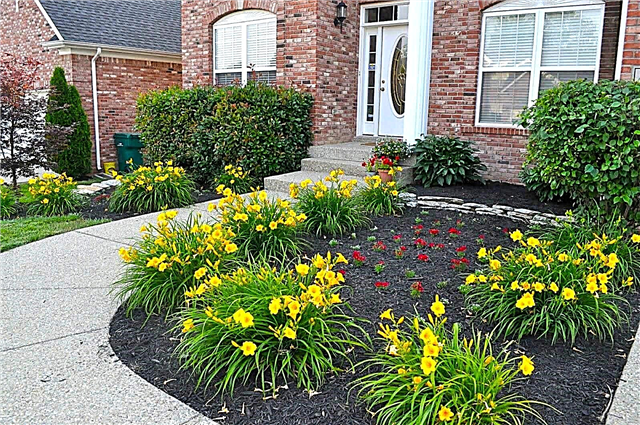
The classic version of the design of flower beds near the house

Blue spruce looks great surrounded by beautiful flowers
Classic low flower bed
The standard solution is a low round flowerbed on which flower crops selected according to a certain plan are placed.
For marking, a rope is used, which is tied in the center of the future structure and a circle is drawn with a peg on the other edge. Choose soil to an average depth of 25 cm, while trying to completely level the surface.
Advice! To protect the plantings from hard-to-eradicate weeds, the bear, the bottom of the recess is lined with geotextiles.
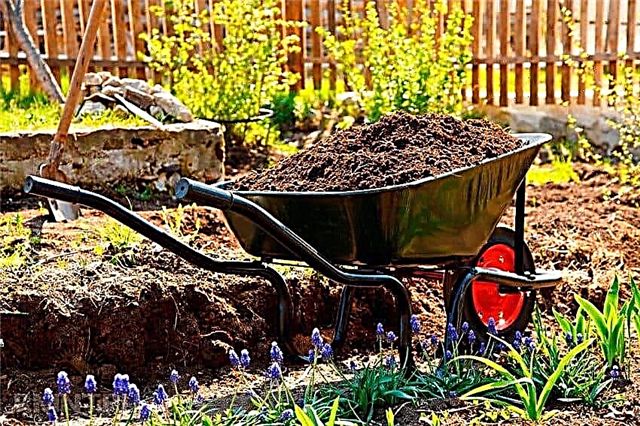
To carry soil with a wheelbarrow is simple and convenient.
If the soil on the site is represented by heavy loam, then gravel drainage is additionally placed, performing a layer about 7 cm high. Then a soil mixture is prepared, combining the excavated soil and rotted compost. At the same time, phosphorus-potassium fertilizers are added, hoping that 25 grams of this drug will be needed per square meter.
The prepared soil substrate is laid out on the drainage pillow so that the edges of the future flower beds are raised above the ground. If necessary, perform a decorative fence that protects the embankment from erosion by rain and gives a special decorative sound.

When planting flowers on a flowerbed, it is important to provide for them the most comfortable conditions.
Ideas for creating beautiful flower beds in the country (photo)
The desire for an innovative experiment allows you to realize your own creative ideas for arranging unusual flower beds with various ornamental motifs and tint combinations. They give the suburban area a complete look and great design. Having looked at ideas and photos on the Internet, you can pick up various options.
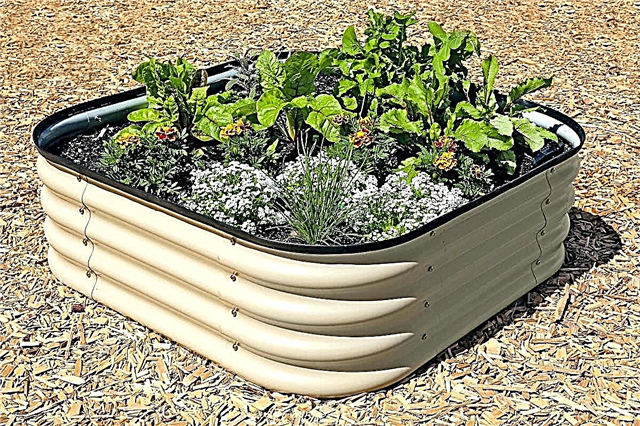
Ribbed flowerbed is very strong and durable.
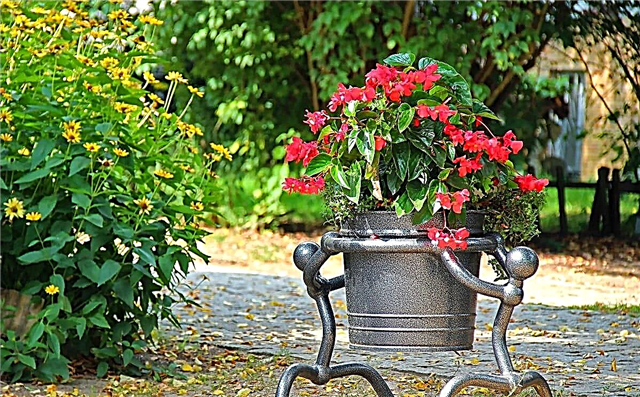
Decorative forged objects harmoniously complement the surrounding landscape
Two colors
On the flower beds of any configuration, you can perform an interesting composition, picking varieties of two shades. In this case, the pattern can be very different.
For example, one color creates a central bright spot, and the second frames it, giving a unique sound. In such a situation, a contrast solution is required. You can make a drawing of the night sky, pick up other variations.
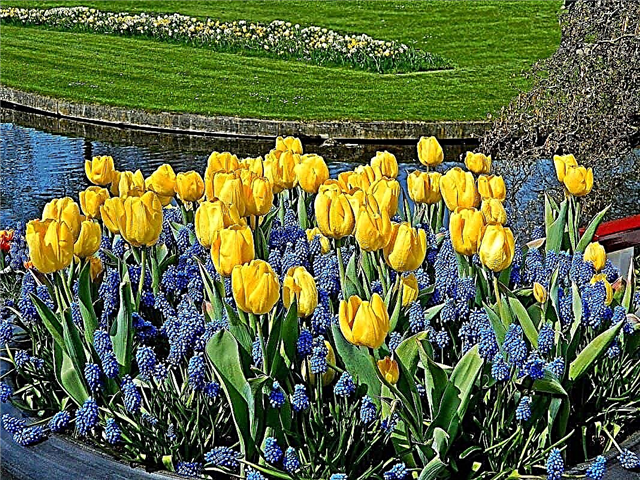
The combination of blue and yellow looks beautiful in any performance
Application of pots
It is convenient to create a flower bed from already flowering plants that were previously grown in pots. They are put on the steps near the house, suspended on strong ropes or completely buried in the ground on a designated area. As the flowers wither, the varieties will be easy to change.
If desired, make another arrangement, select a new color scheme. Such a mobile flower bed easily moves to another place.

Flowers in clay pots look great
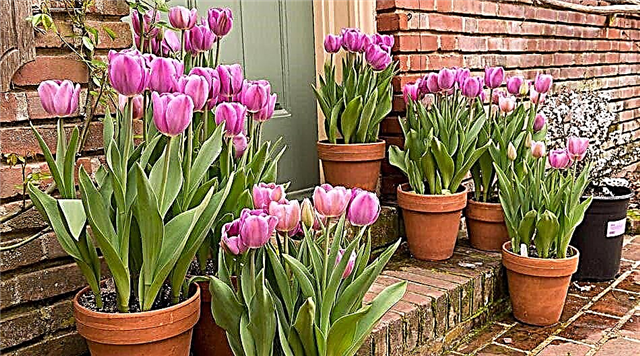
The use of tulips to decorate the porch of a house has become a fashionable trend in modern landscape design.

A variety of colors and paints will please their master for a long time

Planting flowers in pots is a simple and creative solution for planting tulips
Vertical flower beds
There are many options for solving such a flower garden. Pipes are successfully used, in which the side wall is cut out, filled with soil, plants are planted and suspended in several tiers. It is easy to decorate the wall of the gazebo by placing on it a pot with pots and flowering crops.
If desired, make a special design - wooden or metal with several tiers, most often in the form of a pyramid. For this purpose, boxes of various sizes and containers are used, which are laid out at the desired height. Fit old stairs, chests of drawers, shelving.

The multi-level design of wooden boxes is great for planting undersized species of plants

One of the advantages of vertical flower beds is their mobility.
DIY flower beds from improvised materials (photo)
Using a creative approach, you can implement a fashion trend that has been actively sounding for the past few years and involves the use of a variety of obsolete items to design flower beds.
Chairs, armchairs, umbrellas, carts, beds, bicycles, wheels are being restored. Finds the use of old buckets, watering cans, shoes. If desired, they are primed and turned into real art objects, covered with various patterns, decorated with beautiful pebbles, shells, mosaics.

Incredibly beautiful and stylish man-made decor in the form of an old bicycle decorated with flower pots with flowers

Old things are also objects of art, if you find the right approach to them

At the summer resident with golden hands, not a single old thing is wasted
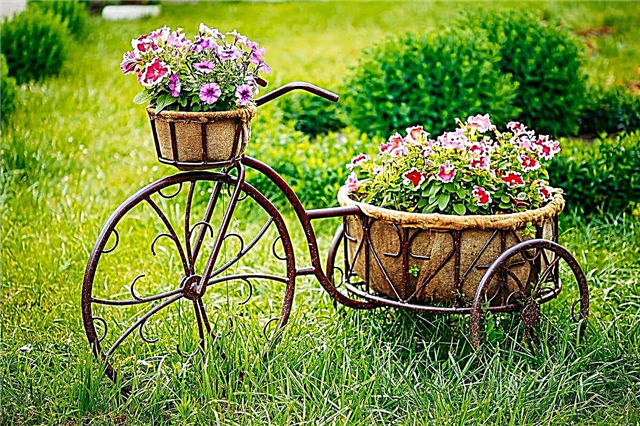
The original idea of decorating the site
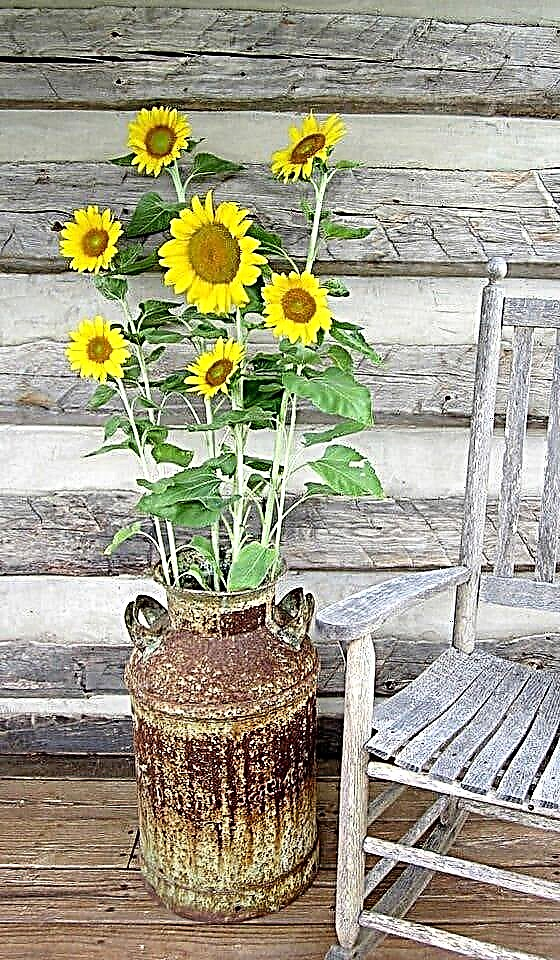

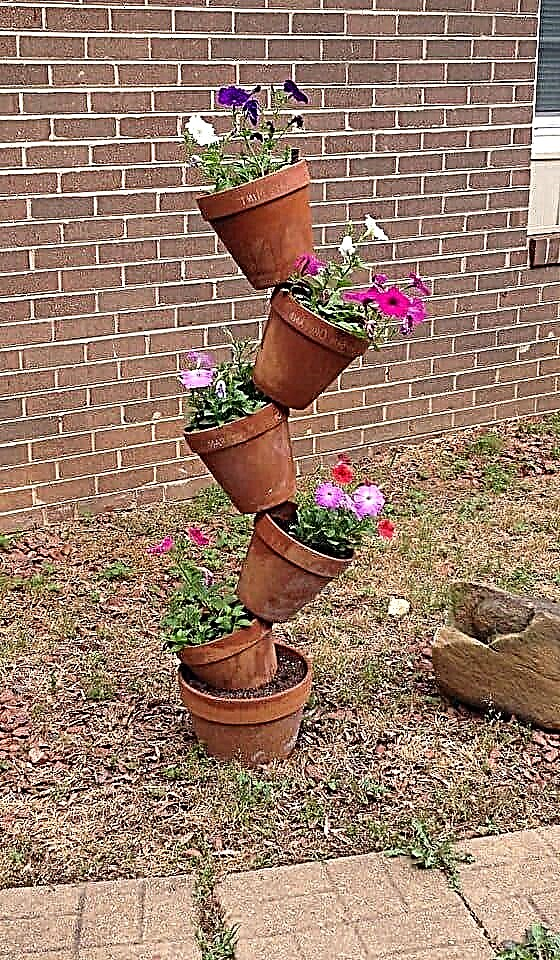
Flowers on a stump
Cutting down old trees, leave stumps that perfectly serve as the basis for a beautiful and elegant flowerbed in the country. It is enough to hollow out a depression in the center, place a vessel with earth in it and plant your favorite plants. A log in which a place is prepared for the soil is useful by squeezing the side part.

Flowers on a stump - will always be in the center of your attention

The second life of car tires
Used tires remain in demand in the design of flower beds, which attract attention with quick installation, the ability to compose various compositions, and mobility. They can be primed, painted.
In the presence of artistic abilities, they apply interesting patterns, whole pictures, decorate them with marble, malachite, wood and other natural objects. In this frame, any unpretentious plants will look advantageous.

Non-standard use of an old car tire as a hanging flowerbed on a tree
Stone fence
Perfectly strengthens and decorates the edges of the flowerbed of any configuration masonry. If a static flower garden is planned, then a cement-sand mortar is used during the construction, which makes it possible to make such a frame durable and strong. It looks elegant even without greenery.
Low flower beds can simply be covered with cobblestones or pieces of brick. Elements of such a frame, if necessary, are easily transferred to another place.

For a beautiful design of flower beds in the country, you can use ordinary stones
Flower beds from bottles
To design the perimeter of flower beds, bottles are increasingly used - plastic or glass. If necessary, they are selected in the same color. Set vertically with the bottoms up, digging into a previously dug trench.
Under the bright rays of the sun, such objects look very beautiful and spectacular, creating enchanting light overflows. Unusual sound amplifies, if you pick up bottles of different colors. Before installation, it is recommended that they be filled with earth for stability.

Using bottles as a fence for a flowerbed is a very bold but justifiable solution.
Wooden railing
Wood always looks prestigious, interesting, unusual. To design the perimeter of flower beds, tree cuts, dies, trim boards, lining, picket fence are used. Make wattle from willow vines, build low fences. There are many options.
Flowerbed under the tree. If the area of the site is limited by free acres, the output will be the planting of flowers near (around) the tree. At the same time, it is important to choose shade-tolerant and unpretentious varieties of flowers and plants.

Bright flower bed under the crown of a tree

Unpretentious species of low flowers are well suited for planting under a tree
Creative ideas for creating a flower garden
Having laid a large pot on its side with a soil mixture inside, create a flower stream, planting plants, starting directly from the neck. The winding line looks especially impressive.
If the site has a small pond, fix miniature pots with flowering plants on the foam and lower it into the water. Such floating flower beds add a romantic touch to the surrounding atmosphere.

The original flower pillar is created from a mesh netting rolled up in the shape of a cylinder. They fasten it with wire, cover the inner space with agrofibre and fill it with soil. In the cuts cut on the side walls, ampelous varieties of flowers are planted.

Do-it-yourself flowerbed will be the pride and decoration of your site
The independent creation of flowerbeds becomes fascinating and fruitful if you approach it creatively and systematically. The introduction of their own ideas into ready-made solutions makes any version of flower beds unique and original.
Flower Garden
The flower garden, which landscape designers call the curb, is a bed of elongated shape. This flowerbed usually has a width of 30-50 cm. With its help, you can focus on any particular part of the garden, so it can border the path, thereby smoothing the corners of the garden, or a green lawn, visually attracting to it. However, in this case, it is necessary to plant undersized plants in the flower bed, not higher than 40 cm in height. A flowerbed looks especially impressive if you plant deciduous and decorative plants in it, because unlike flowering crops, they always look attractive, and not only when they bloom.

The contours of such a flower bed should be correctly drawn, which can be emphasized using a special garden tape. It will allow you to preserve the outlines of the flowerbed that you originally created, preventing the plants from growing, which is typical for many perennial crops.

How to make a mixborder
In a mixborder mixed flowers of different species and habit. Here, annuals and perennials, shrubs, herbaceous plants, and small trees can coexist. It is believed that a flower garden of this type is broken at the fence or wall, but this is not necessary. It looks great near the border of the garden against the background of tall trees, and can serve as a dividing strip between different zones of a summer cottage.
 Mixborder with Dahlias
Mixborder with Dahlias
The basic rule of creating a mixborder is that the plants are planted “in growth”. In the foreground of the flower garden, stunted flowers are placed, representatives of the fauna of medium height are located behind them, and at the very end the highest plants are planted.
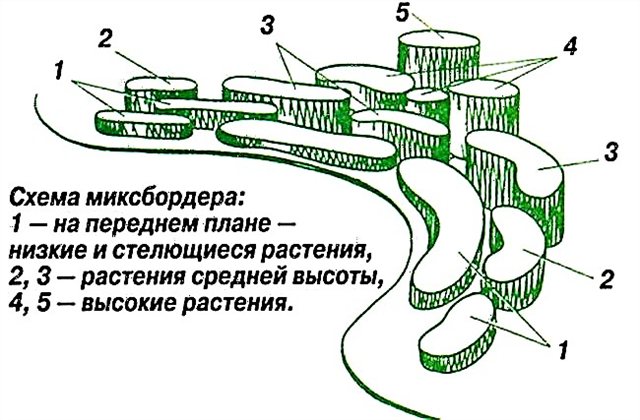
Flowers are selected not only in height, but also in flowering periods. In each tier should be present plants that bloom at different times of the year. This will ensure the elegance of the flower garden throughout the season.
The mixborder looks very nice against the background of conifers: thuja, firs, pines. In this case, the evergreen boxwood, creeping junipers and dwarf spruce are included in the flower garden, which will complement the stylistic orientation of the mixborder.

Helpful advice. Perennials with a powerful root system should be protected with a border tape, which will help control their growth and protect other, less hardy plants.
Landscaping of a paved courtyard
The yard, covered with paving slabs or paving stones, is very convenient, since it is easier to keep it clean even in slush. But with the design of the paved area, problems may arise. Mobile landscaping comes to the rescue: flowers are grown in flowerpots of various sizes and hanging flower pots.

Flower pots are placed along the curbs, at the entrance to the house, near the gate. Thanks to this approach, original flower beds are created that are easily updated depending on the situation. For example, flowerpots can be easily moved if necessary to make room for parking or holding a family celebration.
 Original idea - flowers in hanging flowerpots
Original idea - flowers in hanging flowerpots
Another way to green a cobbled yard is to start laying the tiles, stepping back from the fence 50-60 cm. The free space is used to create a floral border. This method helps to achieve two goals: revitalize an empty yard and disguise the fence, the walls of the outbuildings.
 Stone flowerbed with thuja and annuals
Stone flowerbed with thuja and annuals
Tip. If the courtyard is very small, it is better to plant curly plants along the fence, and in the foreground there are undersized bright annuals. A narrow strip of land, planted with flowers, will create the illusion that the yard does not end immediately after paving, but just behind it the garden begins.

 Hydrangea along the fence
Hydrangea along the fence
The use of stones in the design of the cottage
An original way to make exclusive the landscape of a summer cottage is to use natural stones in its design. There are two main types of flower beds using stones: rockery and rock garden. The difference between them is that in rockeries the emphasis is on blocks of stone, and in rock gardens on flowers and plants.
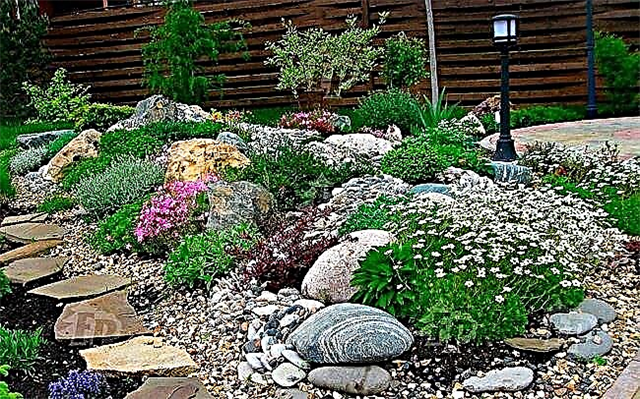 Alpine hill - harmony of stones and vegetation
Alpine hill - harmony of stones and vegetation  Rockery - focus on stones
Rockery - focus on stones
How to make a rockery
Large boulders are placed on a flat platform in a pre-thought out order. The largest of them dig into the soil, so that the composition looks more natural. After that, smaller groups are laid out stones of smaller dimensions.
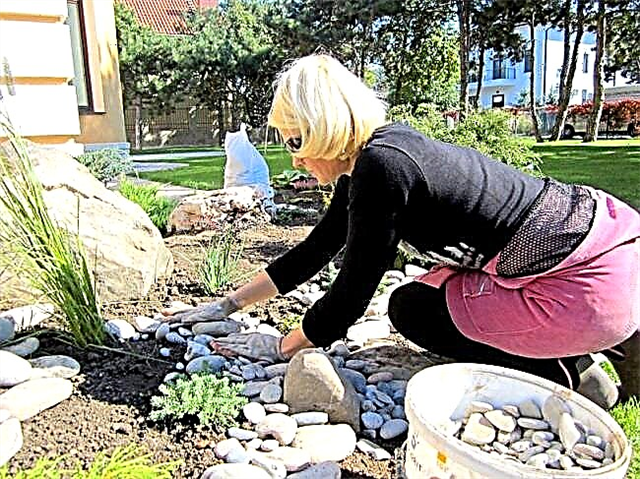
In creating a rockery, it is desirable to use stones of the same breed: sandstone, granite, slate, limestone, tuff. The space between the boulders is covered with sand, gravel or gravel of small fractions. Background bedding is recommended to make a contrast with respect to the stone blocks color.

Plants are planted last. They should not dominate rockeries, therefore it is better to plant hardy species that do not attract special attention: decorative onions, twig (Spanish gorse), pampas grass, blue fescue or other cereal crops for the garden.

How to make a rock garden
Stones are also used in the creation of the Alpine slide. They are laid out on a pre-poured earthen hill, and suitable vegetation is planted in the gaps: saxifrage, tenacious, stachis and other ground cover plants.
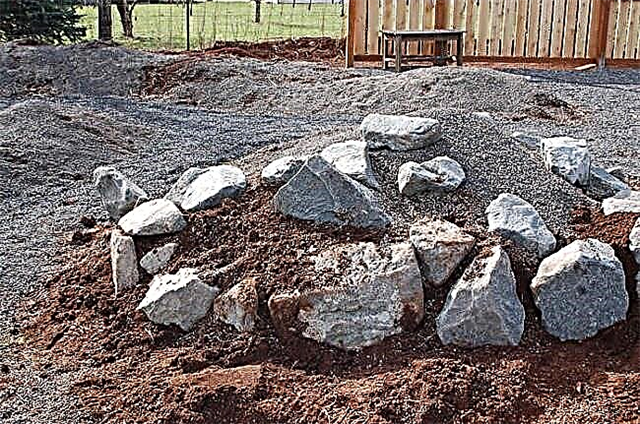

Also used are bright creeping and stunted perennials: Aubrietta, pechat, clove grass, gentian and others. Creeping juniper, dwarf pine, and boxwood also look very good in rock gardens.

The height of the slide can be different, from half a meter to 2 meters. It all depends on the size of the suburban area. If the rock garden is low, it is better to do it against the background of conifers, for example, fir, thuja.

Tip. To prevent the germination of weed grass, the area under the rock garden is covered with geotextiles. Holes are made in it at the planting sites, and the rest of the area is covered with stones.
The same rule applies when creating a rockery.
If there is no time to care for the flower garden
It so happened that a visit to the country is not regular. Because of this, care for flower beds is not always done on time. In this situation helps out moorish lawn.
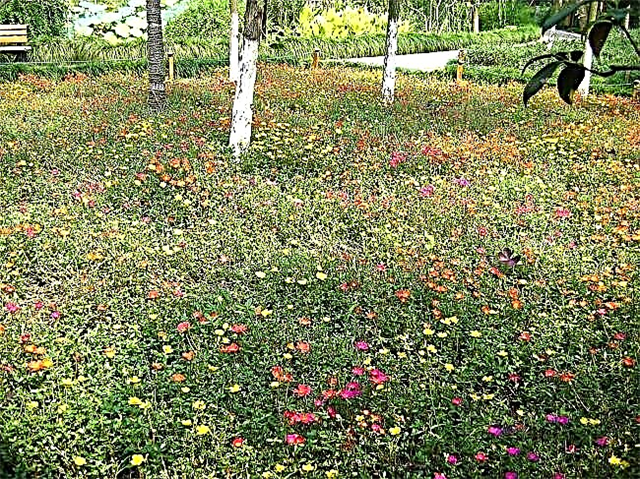
It should be noted that he has very little in common with an ordinary lawn. Firstly, he does not need a constant haircut, and secondly, he is very smart. The Moorish meadow (or lawn) consists of 70% of cereal crops and field grasses and 30% of unpretentious garden flowers. The flowering of the lawn continues throughout the summer, so it looks great throughout the summer season.

The main plants used in the creation of the Moorish meadow:
- Field poppy
- Knapweed,
- Echinacea
- Scabious,
- Tansy,
- Nigella
- Decorative bow.
Attention. When choosing plants for a flowering lawn, their habit should be taken into account. All of themshould be approximately the same height and none of them should dominate.
Monoclumba - stylish and simple
Traditional lawns are easy to revive with a monoclomb - a small flower meadow on a green shorn carpet. In the center of the lawn, the soil is removed along with grass, the plot is fenced with a flexible curb, and the interior space is filled with fertile soil mixture. In the resulting "window", any flowers suitable for the country landscape are planted.
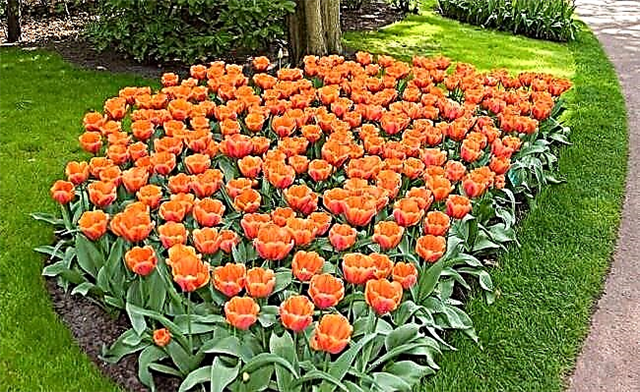 Monoclumbia with tulips
Monoclumbia with tulips
If bulbs (tulips, daffodils) are used, after the end of their flowering in a monoclomb, you can plant bright annuals: petunia, viola, tagetes, zinnia, celosia and others.
 Daffodils in a monoclomb
Daffodils in a monoclomb
Majestic roses and graceful cannes look very nice on the green of the lawn.
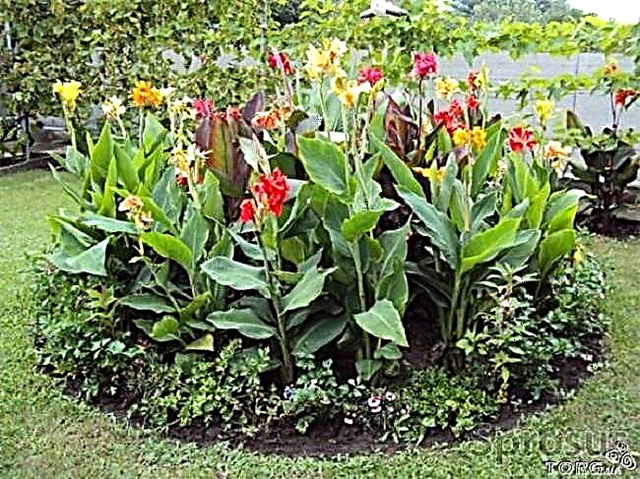
Plants with variegated (variegated) foliage will help to create an unusual composition, for example, creeping species of fortune euonymus, variegated brunner, some types of host, and budra willi.
In the country, you can create just one small flower bed or several types of flower beds. In any case, they will become the decoration of the site, uplifting and disposing to rest.
Stone garden
The stone garden looks quite impressive in the summer cottage. It is not difficult to organize a stone garden on your site, in addition, modern landscape designers offer a lot of options for its design.

The main thing when creating a stone garden is to use the natural relief correctly, and so that the whole garden is organized in the same style.

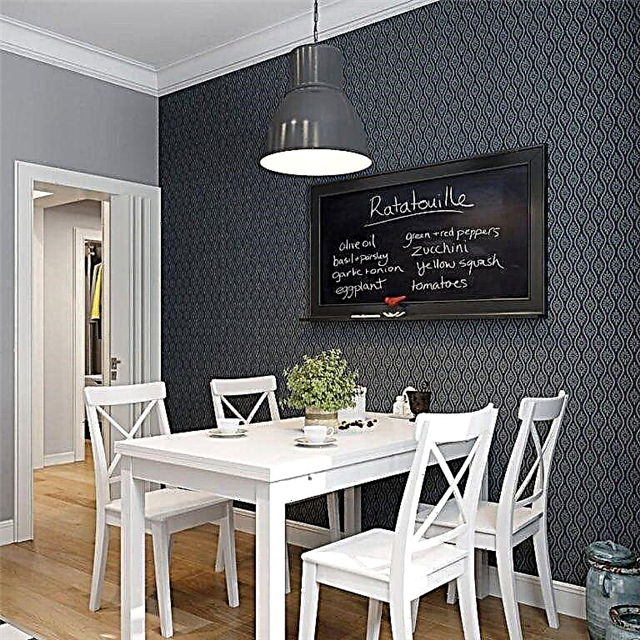

If the site is located at the bottom of the slope, it is best to use retaining walls or make a terrace.

 The same rule applies when creating a rockery.
The same rule applies when creating a rockery.

